What's So Bad About Shoes?
The Side Effects of Metal Shoes
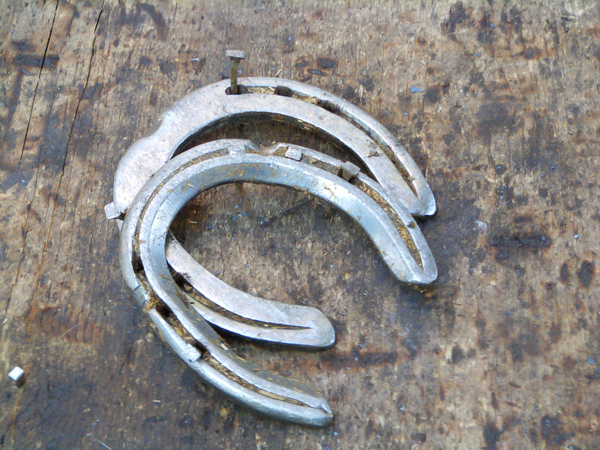
If the foot does not need a shoe, then why is it shod?
And if it does need support, is a metal shoe the best choice to support it?
Equine podiatry is a shoeless approach. It focuses on making horses feet healthy enough so that they can perform without shoes. But it raises the questions - why is the horse in shoes to begin with? What is so bad about shoeing, and is a healthy shod foot a contradiction of terms?
When Did Shoes Become Evil?
When i was introduced to horses, I was not aware of any other approach of hoof care. In fact, many people too also assume that shoes are a required aspect of keeping a horse, much like feeds and rugs. A lot of horses seemed to be sore without them, so surely that was a sign that the shoes are needed for doing anything outside of the paddock.
Shoes are a modern convenience for many horse owners. They allow you to do more than the foot is able to do without the shoe, so by definition are a performance enhancer, or prosthetic. This sounds like a good thing, but there are side-effects of having shoes on, and an understanding of what a shoe can do to the foot is important in making a decision about whether they are appropriate to place on horses feet.
This article will outline some of the side-effects that metal shoes can have on the foot, and why, as an EP, I rarely suggest their use when creating a healthy hoof.
Impeded Development
The skeletal structures in a horses foot do not stop growing until they are around 6/7 years old. Applying a fixed shoe to the bottom of a growing foot can impede it's development, similar to what used to occur in the chinese culture, where the feet of a child would be bandaged so they remain small.

The long-term effect of a shoe is that it weakens the internal structures that should naturally be weight-bearing - the typical scenario being a horse that is sound in shoes, but lame without them, is seen as "needing" shoes, instead of more accurately being perceived as having weak feet.
An example to illustrate my point: if you were to break your arm, and it were put in plaster for 6 weeks, the muscles in your arm would naturally weaken (atrophy) through loss of use and natural flexion. If you were to remove the plaster cast and realise the muscles in your arm were weak, your solution would not be to put your arm back in plaster! The same is true of the hoof. It needs correct stimulation to be strong, and without that, it may not even be strong enough to support the horse above it.
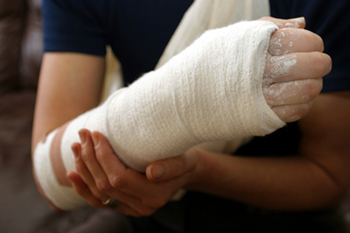
"But my horses feet will wear down quicker than they will grow?"
Common misconceptions are that the feet will either stop growing without shoes on, or wear away more quickly than they grow, but neither are really true.
The development of the foot, or any tissue in the body for that matter, is directly related to the forces exerted upon it. There is a cycle; the more work you do, the healthier the foot becomes. The more the foot is stimulated by exercise and different surfaces, the more it grows. Hard working horses may not need their feet trimmed as often as other horses, as the wear and growth equal each other.
"But I need more grip"
Commonly studs are used to increase traction with shoes for stablity[1] in wet and muddy conditions, sometimes road studs are also used. However these basically transfer torsion and shear forces higher up the leg, into joints, muscles, tendons and ligaments. The foot is supposed to slip a little with every step[2], and efforts to prevent this natural mechanism can lead to greater muscoskeletal problems.
The back of the foot is naturally designed to grip the terrain it is on; a leathery, triangular shaped wedge (the frog), bars that dig into the ground, and collateral grooves which gather material, are all far a superior design and obviously provide more grip on, e.g, tarmac, than a metal shoe would. This is one of the reasons the Houston Police Department Mounted Police Unit all ride barefoot horses.
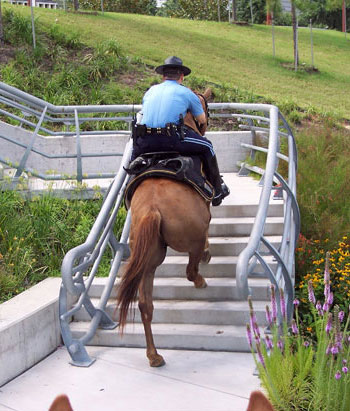
Disciplines, some that typically involve studded shoes, are having great success with barefoot horses: eventing [3], dressage [4] [5], racing [6], endurance [7] etc. with more and more people gaining a competitive edge from being unshod.
"In 2003 the Houston Police Department Mounted Patrol was the first unit to initiate a bare foot program for all law enforcement agencies in the United States and the program has proven to be a great success. We no longer utilize a farrier and over this period of time we have had very little hoof problems"
An aside to the above quote: i don't necessarily think that the success of the Houston PD is down to getting rid of the farrier (there are farriers in the UK with a sound knowledge of barefoot principles), but getting rid of the shoe.
Reduced Proprioception
The sense of knowing the location of your appendages is known as proprioception. For instance, if you were to close your eyes and hold your arm out to your side, you would have an awareness of the position of your arm without seeing it.
Recent research shows that the horses hoof is more like a sensory organ than something just to stand on. Many different types of sensory receptors, each with it's own purpose of registering impact, temperature, vibration, and pain have all been found in the horses foot [9] [10] - and they are mostly located at the back of the foot.
Barefoot horses have increased proprioception due to the sensory receptors being properly engaged and not masked by a shoe. This may be one reason why a horse that trips or stumbles a lot when shod, stops doing so when unshod.
Increased Concussion
A metal plate on the underside of the foot is obviously going to increase concussion on hard surfaces. Below are some videos that illustrate this.
When a shoe is applied, it effectively lifts the foot off the floor. Structures that were designed to be weight bearing and absorb concussion are no longer used. The sole (with the exception of the periphery), frogs and bars are no longer engaged, and this leads to weakening of these structures. Engagement of the frog in particular is highly important because it transfers forces to the digital cushion and lateral cartilages. When these are not used for a long time, they weaken.
Bowker found almost all of the navicular horses he dissected had poor digital cushion and lateral cartilage development[11].
A metal rim fixed to a flexible object is also going to cause a restriction of flexion. Whilst a shod foot can still expand at the heels, there is greater expansion in unshod feet.
A more recent study also confirmed that a barefoot horse was much better at reducing the effects of impact, and absorbing and dissipating more concussive forces than a shod foot[12].
Peripheral Loading
A shoe results in the majority of the horses weight being suspended on the outside of the foot. As other weight-bearing structures are lifted from the floor, the walls and laminae are taking the entire weight of the horse.
Bowker also wrote in 2013 on how peripheral loading can cause osteoporosis of the pedal bone[13]. In horses that use all the weight bearing stuctures correctly, collagen fibres coming from the thin covering of the pedal bone (the periosteum) are flat against this surface. When a foot is peripherally loaded, the upward movement of the walls and downward movement of the pedal bone cause the collagen fibres to attempt to stablilise this excess movement by changing their orientation, and digging into the surface of the pedal bone. They act almost like anchors, creating holes in the bone surface, resulting in osteoporosis."There has never been a study showing that the hoof wall is the actual loading structure but this premise is accepted as dogma."
Furthermore, a shoe only really fits the hoof for a week or two. After that time, the hoof has grown (taking the shoe with it), and since there is no wear to the walls, the whole foot just gets longer, often making the toe longer (increasing breakover) and the heel more underrun. This was identified in the 1800s by vet Bracy Clark, whose drawings of the changes in foot shape during a period of being shod may illustrate the consequences of (possibly poor) shoeing.
It is important to point out that peripheral loading can occur when a horse is barefoot too. If the wall is left too long it can act like a natural shoe, and lifts the weight bearing structures from ground contact.
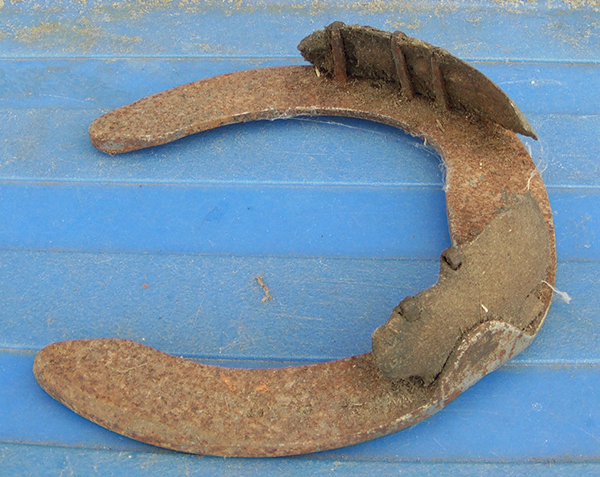
Image courtesy of LKG.
Metal shoes are nailed on through the white line and hoof wall. Not only does this obviously weaken the wall structure, but it allows an entry route for bacteria to get into the wall: the black discolouring you see around a nail hole is bacteria and fungus. If the nails are clenched too tightly, it can restrict blood flow to the underlying laminae. Combined with other health issues such as white line disease, the shoe can come clean off, taking large chunks of hoof wall with it.
An Outdated Technology
This leads onto my biggest issue with metal horse shoes - they are simply an outdated technology. The basic concept has not changed for the past thousand years or so, despite the understanding of hoof anatomy surging forward in recent years.
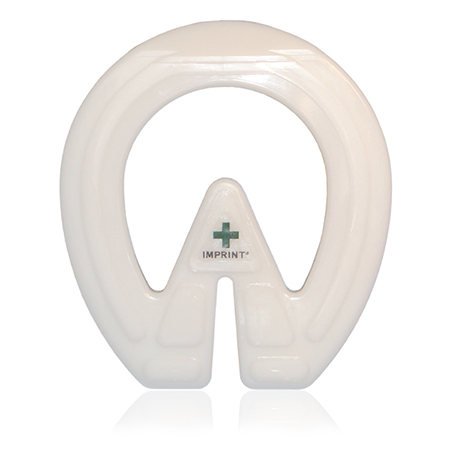
The shoeing industry seems to have recognised this, and the past 10 years has seen an advancement in the development of plastic or rubber shoes, with many different types available[14]. Many of these are glued on instead of nailed on.
Whilst this certainly addresses the issue with concussion, they still peripherally load the foot, and do not engage the weight bearing structures in the same way that being barefoot achieves.
I am under no illusions that some horses feet will require protection, but there are better, modern ways of providing this, such as hoof boots. These are only applied to the hoof when protection is needed, and removed all other times. They can also be fitted with therapeutic pads to actively develop or rehabilitate weak weight bearing structures, so encourage foot development instead of inhibiting it.
Conclusions
If your horse needs shoes, ask yourself, why?
There is no doubt that making a shoe from a piece of straight metal bar to the shape of a horses foot is a highly skilled craft. Keeping in mind the principle of a shoe as a prosthetic naturally leads to situations where there may be a genuine need for one in the short-term where benefits outweigh the side-effects. However the majority of domestic horses do not need a prosthetic; they need a stronger foot. This is clearly apparent when a horse has been continually shod without a break from shoes to allow the foot to recover from the side-effects of shoeing.
Shoes are very successful at masking low levels of inflammation from poor nutrition, and make an unsound foot appear more capable than it is without the shoe. Both instances point to underlying problems that need to be addressed, instead of plastered (or nailed) over. A lot of foot pathologies often start as minor lamenesses, minor infections, minor imbalances etc. before escalating into bigger problems. A barefoot approach deals with these problems as soon as they appear.
References
- [1]The effect of lateral heel studs on the kinematics of the equine digit while cantering on grass Harvey AM1, Williams SB, Singer ER. Vet J. 2012 May;192(2):217-21. doi: 10.1016/j.tvjl.2011.06.003. Epub 2011 Jul 12.
- [2]Slip & Grip - It Is A Fine Line http://www.americanfarriers.com/articles/5920-slip-grip-it-is-a-fine-line
- [3]Eventing Barefoot: Is It Possible? May 21 2014 http://eventingnation.com/eventing-barefoot-is-it-possible/
- [4]Keeping Horses Barefoot: a Healthy Horse From the Ground Up http://www.eurodressage.com/equestrian/2013/02/09/keeping-horses-barefoot-healthy-horse-ground
- [5]Barefoot Dressage with Shannon Peters February 2013 Dressage Today 02/09/2013 http://dressagetoday.com/article/barefoot-dressage-with-shannon-peters-12540
- [6]Simon Earle Racing - How We Train Our Horses http://www.simonearleracing.com/how_we_train_our_horses.html
- [7]Dr Steven Roberts BVSc, The Barefoot Endurance Horse Vol 1, http://www.nswera.asn.au/newsstories/articles/28-the-barefoot-endurance-horse-vol-1.html
- [8]Houston Police Department
- [9]Sensory receptors in the equine foot. Bowker RM1, Brewer AM, Vex KB, Guida LA, Linder KE, Sonea IM, Stinson AW. American Journal of Veterinary Research. 1993 Nov;54(11):1840-4
- [10]Bowker RM, The Horse's foot as a Neurosensory Organ: How the Horse Perceives its Environment, 2013 Care & Rehabilitation of the Equine Foot by Pete Ramey
- [11]>Bowker RM, Contrasting Structural Morphologies of "Good" and "Bad" Footed Horses AAEP Proceedings vol. 49 2003
- [12]Equine hoof function investigated by pressure transducers inside the hoof and accelerometers mounted on the first phalanxDyhre-Poulsen P, Smedegaard HH, Roed J, Korsgaard E., Equine Veterinary Journal 1994 26(5) 362-366
- [13]Bowker RM, The Suspensory Apparatus of the Coffin Bone, No Laminitis 2013 Proceedings
- [14]Red Renchin, Client Interest in Non-Metal Horseshoes Fuels A Growth In Their Use, September 1 2013